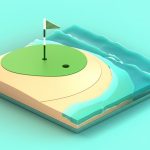Want to say goodbye to expensive driving range fees and weather-dependent golf outings? Imagine having your own personal golf simulator without the hefty price tag. This guide reveals how to construct your very own impressive golf simulator at home, leading to substantial savings. Even if DIY isn’t your forte, we’ll guide you through each stage, from selecting the appropriate equipment to the final assembly. We’ll address everything from the crucial launch monitor to constructing a secure and robust enclosure, ensuring a safe and enjoyable experience. Are you ready to enhance your golf game, year-round, from the comfort of your garage or basement—without exceeding your budget? Let’s get started!
DIY Golf Simulator: Your Dream Setup on a Budget
Let’s face it: those high-end golf simulators commonly found at golf clubs or pro shops come with a hefty price tag. But what if you could construct an equivalent golf simulator at home for significantly less? It’s entirely attainable, and this guide provides a step-by-step walkthrough. Get ready for big savings and countless hours of enjoyable practice! What could be better than improving your swing without breaking the bank and enjoying golf whenever you want?
Planning Your DIY Golf Simulator: Measure Twice, Build Once
Before you consider purchasing a single component, ensure you have enough space. You’ll need a dedicated area—think at least 12 feet wide, 15 feet deep, with a ceiling height of at least 9 feet. Larger is always preferable, especially if you have a long swing or plan on accommodating multiple players. Consider the space needed not only for the hitting area but also for any seating or viewing areas. Imagine yourself swinging freely without feeling confined.
Next, dream big, but realistically. What features are essential for you? A large, high-resolution screen? Ultra-realistic graphics? Accurate swing analysis? The possibilities appear infinite. Remember that additional features typically increase the overall cost. Define your priorities – is it game improvement, realistic simulation, or social entertainment? What kind of experience do you envision?
Before unleashing your inner builder, confirm compliance with local building codes and regulations. This will help you avoid any unpleasant surprises later, especially if you’re modifying a garage or basement. Check electrical requirements, structural modifications, and any potential noise restrictions. Navigating paperwork isn’t always fun, but it ensures you’re on the right side of building regulations. Are you prepared to make sure you are following local regulations?
Choosing the Right Gear: The Heart of Your Simulator
Smart component selection is crucial for managing your budget. It’s about balancing quality with cost, opting for the best value in each category.
-
The Launch Monitor: The Brains of the Operation: This piece of technology precisely measures club and ball data, including ball speed, launch angle, spin rate, and carry distance. Radar-based launch monitors (like TrackMan or FlightScope) offer outstanding accuracy by tracking the ball’s entire flight, but they are usually expensive. Camera-based systems (like SkyTrak or Bushnell Launch Pro) are more affordable and measure data at impact. Hybrid systems combine radar and camera technology for enhanced accuracy at a mid-range price. Consider factors like the range of data parameters, accuracy levels, indoor/outdoor capabilities, and software compatibility. How much accuracy do you need versus how much are you willing to spend?
-
The Projector: Bringing the Course to Life: The projector displays the virtual golf course on your screen, creating an immersive experience. You’ll want sufficient brightness (measured in lumens) to ensure clear visibility, even if your simulator is not housed in a completely dark area. Aim for at least 3000 lumens for a well-lit room. A short-throw projector is a great option because it requires less distance between the projector and your screen, conserving space and minimizing shadows. Look for a throw ratio of 0.8:1 or less. Also, resolution is important – a sharper image will look better and feel more realistic. Choose between 1080p (Full HD) for a good balance of quality and cost, or 4K (Ultra HD) for the most detailed visuals. What is the ideal brightness and resolution for the best simulating experience?
-
Golf Simulator Software: The Digital Course: There is a broad selection of excellent golf simulator software available, each offering a unique experience. Some popular options include E6 CONNECT, GSPro, TGC 2019, and World Golf Tour (WGT). Consider factors like the number of courses, graphics quality, game modes (driving range, course play, multiplayer), online play, and compatibility with your launch monitor. Read some online reviews, compare features, and choose the one best suited to your budget and playing preferences. What features are most important to you in simulation software?
-
Building the Enclosure: Where You Save Big: The DIY part enables substantial savings. The enclosure provides a safe space to swing and houses the impact screen. Various plans are available online to construct a sturdy enclosure using EMT conduit pipes, wood framing, or a combination of both. Consider using heavy-duty canvas, blackout cloth, or dedicated enclosure kits for the side walls to block out light and contain stray shots. Focus on building something strong to ensure your simulator lasts. Pre-made enclosures from companies like Carl’s Place offer a convenient alternative, but at a higher cost. Determine the dimensions based on your screen size and available space. How can you build an enclosure that is both durable and cost-effective?
-
The Hitting Mat: Safety First! A quality hitting mat protects your floor and, importantly, your wrists, elbows, and shoulders! It should provide a realistic feel and absorb impact to prevent injuries. Simple DIY mats offer a cost-effective starting point—you could even get creative with materials like layering foam padding and artificial turf. If you’re aiming for realism and durability, consider investing in a commercial-grade hitting mat with replaceable hitting strips. Look for a mat that allows you to use real tees and simulates different lies (fairway, rough). How can you balance safety and realism with your hitting mat?
-
Impact Screen: The Focal Point: The impact screen is where the projected image appears and where you hit the golf balls. It needs to be durable enough to withstand repeated impacts without tearing or developing visible wear. Choose a screen made from high-quality, multi-layer fabric designed specifically for golf simulators. Look for features like low bounceback, minimal noise, and a smooth, wrinkle-free surface for optimal image quality. Consider the aspect ratio (4:3 or 16:9) to match your projector and software. What netting material will provide the best protection and durability?
-
Netting: Keeping Your Balls In Play: Choose your netting carefully! You’ll need something robust and dependable to prevent golf balls from flying throughout your home (or into your neighbor’s property!). Utilize high-quality netting made from durable materials like nylon or polyester and ensure it’s securely attached to your enclosure. Consider adding side netting or curtains for extra protection. What netting material will provide the best protection and durability?
Assembly and Installation: Putting It All Together
With proper planning, assembling everything is relatively straightforward.
Step 1: Meticulously follow your enclosure plans. A solid structure is essential for safety and longevity. Ensure all connections are secure and the frame is stable.
Step 2: Mount your impact screen securely within the enclosure, ensuring it is taut and wrinkle-free. Use ball bungees or a similar attachment method to distribute the tension evenly.
Step 3: Set up your projector according to the manufacturer’s instructions, adjusting the keystone and focus for optimal picture quality on your screen to make sure that the virtual course looks its best.
Step 4: Install the golf simulator software, adhering to the manufacturer’s instructions. Numerous software packages offer clear, step-by-step guidance.
Step 5: Position your hitting mat in front of the impact screen, ensuring it is level and stable. Consider adding a stance mat or platform to create a more comfortable and realistic playing surface.
Step 6: Calibrate your entire system, paying close attention to the launch monitor, as getting accurate readings is important for a realistic golfing experience. Consult the launch monitor’s manual for specific calibration procedures.
Calibration and Testing: Fine-Tuning Your Masterpiece
Now comes calibration, a critical phase. Carefully follow the launch monitor’s instructions to measure shots with accuracy. Thoroughly test the system as you may need to make minor adjustments to optimize performance. Pay attention to the launch monitor’s data and adjust settings as needed to match your real-world golf performance. This might involve adjusting club settings, elevation, or environmental conditions within the software. What methods will you employ to ensure accurate calibration?
Refinements and Upgrades: The Ever-Evolving Simulator
Consider your DIY golf simulator a project in progress. There’s always room for upgrades! Down the line, you might upgrade to a better screen material for improved image clarity, invest in more advanced software with additional features, or enhance your flooring for improved realism. Consider adding features like surround sound, a comfortable seating area, or even a mini-fridge for refreshments to enhance the overall experience. What potential upgrades might enhance your simulator experience?
DIY Golf Simulator: A Budget Breakdown
Building your own versus buying a pre-built simulator shows you potential savings. Remember that these are only estimates, and prices may vary based on your individual choices. Is the cost savings worth the assembly?
| Component | Estimated DIY Cost Range | Estimated Commercial Cost Range | Potential Savings |
|---|---|---|---|
- Unforgettable: Talking Stick Golf Club Review – Desert Golfing Redefined - November 17, 2025
- Discover Talega Golf Club: Championship Golf & Spanish Hospitality Awaits! - November 15, 2025
- Is Strawberry Farms Golf Club Orange County’s Best Kept Secret? - November 13, 2025









